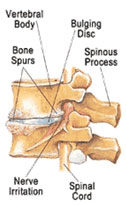Spine
Subluxation or joint dysfunction
The term subluxation means minor misalignment however the affects on the human body as a result of a subluxation on the upper cervical spine can be far from minor. In the simplest of terms, a subluxation is when one or more vertebrae (bones in your spine) move out of line and create pressure on spinal nerves. Spinal nerves are the nerves that come out from the vertebrae in your spine. Pressure on the nerves can cause interference with the signals traveling through them – leading to numerous health related problem.
Chiropractors commonly recognize five categories of components present in the Vertebral Subluxation Complex (VSC).
- Spinal Kinesiopathology – is where the bones of the spine become stuck, don’t move enough, or move too much.
- Neuropathophysiology (abnormal nervous system function) – nerves can become overexcited and hyperactive. Due to the way the spine is engineered, abnormal spinal function can irritate, pinch, rub or choke the delicate tissue of the spinal cord and nerve roots.
- Myopathology (Abnormal Muscle Function) – is when over-developed muscles on one side of the spine cause individual vertebrae to rotate and lose proper function. When muscle function declines muscles that support the spine respond in different ways, the spine can weaken or even atrophy.
- Histiopathology (Abnormal soft tissue function) – inflammation and swelling due to injured disc accompany the accumulation of blood and lymph – causing a rise in temperature.
- Pathophysiology – when there is a trauma to a joint, one of the ways your body responds is the stabilization of the area by forming new bone! With time, calcium deposits build up, eventually as abnormal bony growth. This arthritic ’splinting’ of bones is nature’s attempt to stabilize the injured joint.
Due to the intricacies of the nervous system, more research is being conducted in the areas of hormonal involvement, aging, immune system response, even genetic consequences. The Vertebral Subluxation Complex may be one of the most regular yet overlooked source of health problems.
Chiropractor are trained in identifying and treating vertebral subluxations.This is done through a series of chiropractic adjustments specifically designed to correct the vertebral subluxations in your spine. Chiropractors are the only professionals who undergo years of training to be the experts at correcting subluxations.
Degeneration
Proper spinal alignment is essential for healthy and pain-free living. When there is a trauma to a joint, one of the ways your body responds is the stabilization of the area by formation of new bone. With time, calcium deposits build up, eventually as abnormal bony growth. This arthritic ’splinting’ of bones is nature’s attempt to stabilize the injured joint. If left untreated, subluxation takes the form of ongoing degeneration known as ’subluxation degeneration’ and can lead to chronic health related problems.
As these x-rays show, there is a progressive degeneration that can be halted, or slowed, with proper chiropractic care.

 Proper spinal curves permit normal turning and bending. Openings between joints allow nerve roots to exit the spine without interference. The edges of the bones are smooth and well defined. Equal disc spacing is a sign of healthy spinal function.
Proper spinal curves permit normal turning and bending. Openings between joints allow nerve roots to exit the spine without interference. The edges of the bones are smooth and well defined. Equal disc spacing is a sign of healthy spinal function. Loss or normal curves and misalignment restrict or exaggerate normal ranges of motion. ligament and muscle strength is reduced. Even with nerve irritation and soft tissue inflammation, pain or other obvious symptoms may not be present.
Loss or normal curves and misalignment restrict or exaggerate normal ranges of motion. ligament and muscle strength is reduced. Even with nerve irritation and soft tissue inflammation, pain or other obvious symptoms may not be present. Years of accumulated calcium deposition are now visible. Bone spurs attempt to fuse malfunctioning joints. Adjacent surfaces are rough and uneven. Joint instability is accompanied by continued nerve irritation and disc degeneration.
Years of accumulated calcium deposition are now visible. Bone spurs attempt to fuse malfunctioning joints. Adjacent surfaces are rough and uneven. Joint instability is accompanied by continued nerve irritation and disc degeneration. After years of neglect, complete fusion has immobilized the joint. Obstructed nerve openings cause permanent nerve irritation as soft tissue degeneration continues. This irreversible condition is usually associated with other chronic health problems.
After years of neglect, complete fusion has immobilized the joint. Obstructed nerve openings cause permanent nerve irritation as soft tissue degeneration continues. This irreversible condition is usually associated with other chronic health problems.